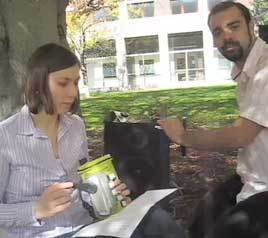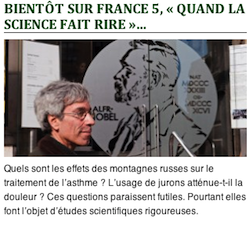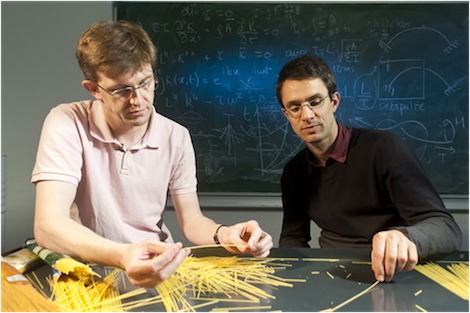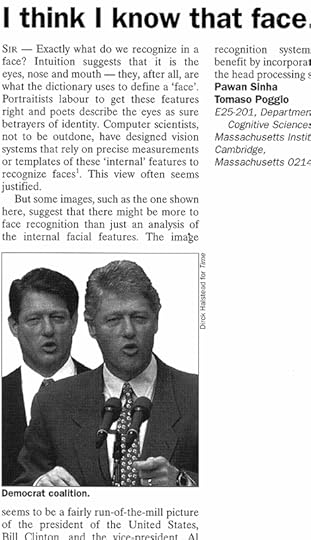Marc Abrahams's Blog, page 548
September 14, 2012
A helping of Rube Goldberg, please
For engineers, designers, and all other persons who love, love, love complexity, it’s almost always a good time to visit the Rube Goldberg web site. Here’s a panel from one of Rube Goldberg‘s many cartoons:

September 13, 2012
Chickens, Consciousness, and the LHC
 Dr. Dainis Zeps, a Senior Researcher at the Institute of Mathematics and Computer Science of the University of Latvia, is one of the very few to have investigated “hierarchical multitime notion and of the cone of creation” with reference to CERN’s Large Hadron Collider.
Dr. Dainis Zeps, a Senior Researcher at the Institute of Mathematics and Computer Science of the University of Latvia, is one of the very few to have investigated “hierarchical multitime notion and of the cone of creation” with reference to CERN’s Large Hadron Collider.
His paper on the subject, ‘On to What Effect LHC Experiment Should Arrive’ (Prespacetime Journal, March 2010, Vol. 1, Issue 2, pp. 244-251) attempts to clarify some of the highly complex implications of a possible Higgs Field by use of a ‘Chicken and Egg’ diagram [above].
“What is what in the picture of two chickens? The chicken in the first picture is the physicist before LHC experiments. He is trying Higgs bosonic field with his beak, i.e., LHC. Smashing it, he finds inside it himself, i.e., the world behind Higgs field is the same world, but rather in the new, hierarchical multitime setting. How to picture the fact that chicken’s consciousness has been changed, author did not invent. It must be imagined or lived over by ourselves.”

Working for your notes
 How can today’s “Electronic Troubadour” musicians claim to be truly independent if they have to keep plugging into the corporate-and-establishment-controlled electricity power grid? Noah Vawter, PhD candidate and research assistant at the Computing Culture Group of MIT Media Lab, has created the concept of Exertion Music. The key point is that an electronic musical instrument could harvest its required electric power directly from the player – the musician will need to exert him/herself in order to power-up their battery-free instrument via an onboard generator. And the Physically Engaged Exertion Instruments described in Mr. Vawter’s PhD proposal might provide a way. For an example video of the prototype instruments in action see : Hey Jude Duet (Quicktime® .mov format)
How can today’s “Electronic Troubadour” musicians claim to be truly independent if they have to keep plugging into the corporate-and-establishment-controlled electricity power grid? Noah Vawter, PhD candidate and research assistant at the Computing Culture Group of MIT Media Lab, has created the concept of Exertion Music. The key point is that an electronic musical instrument could harvest its required electric power directly from the player – the musician will need to exert him/herself in order to power-up their battery-free instrument via an onboard generator. And the Physically Engaged Exertion Instruments described in Mr. Vawter’s PhD proposal might provide a way. For an example video of the prototype instruments in action see : Hey Jude Duet (Quicktime® .mov format)
Notes:
• Quite a few non-electronic musical devices might also fall into the category of Exertion Instruments – see for example :
• Noah Vawter is also one of the co-authors of the now famous 2010 investigation: On the Effectiveness of Aluminium Foil Helmets.
• For another human-power concept see : Implementing a knee-energy harvester (Improbable Research October 2011)

Pluto & Psychiatric Disorders & Apples & Oranges
A good comparison can be hard to come by. This new study offers a brand new comparison:
“The Removal of Pluto from the Class of Planets and Homosexuality from the Class of Psychiatric Disorders: A Comparison,” Peter Zachar and Kenneth S Kendler [pictured here], Philosophy, Ethics, and Humanities in Medicine, vol. 7, no. 1, 2012. The authors, at Virginia Commonwealth University Medical in Richmond, report:
“We compare astronomers’ removal of Pluto from the listing of planets and psychiatrists’ removal of homosexuality from the listing of mental disorders. Although the political maneuverings that emerged in both controversies are less than scientifically ideal, we argue that competition for “scientific authority” among competing groups is a normal part of scientific progress. In both cases, a complicated relationship between abstract constructs and evidence made the classification problem thorny.”
(Thanks to investigator Matt Walker for bringing this to our attention.)
BONUS: Scott Sandford‘s classic “A Comparison of Apples and Oranges”
BONUS: Apples & Oranges & Comets

September 12, 2012
A smidgen of mathematical levity, plus 58 minutes
In this first video, Fry and Laurie present a calculated bit of mathematical levity [HT Jennifer Ouellette]:
In the following video, Professor Bikash Kumar Dey of the Department of Electrical Engineering, IIT Bombay, presents 58 minutes without levity. It’s his famous “Lecture – 22 Probability of Error Calculation”. Enjoy, if you will:
BONUS: “Lecture – 24 Calculation of Probability of Error“

September 11, 2012
Nice, creepy video of an all-polymer robot that can undulate
Chemical & Engineering News produced this video of a soft-bodied robot that undulates. The narrator sounds as if she is trying to impersonate the robot:
C&EN gives more details in an accompanying article, which says:
Led by George M. Whitesides, the scientists have constructed an all-polymer robot that can crawl and undulate backward and forward, even navigating obstacles (Proc. Natl. Acad. Sci. USA, DOI:10.1073/pnas.1116564108). Fabricated with soft-lithography techniques used to build microfluidic devices, the robot moves via a series of inflatable chambers embedded between layers of the stretchy commercial elastomer Ecoflex and the more rigid plastic polydimethylsiloxane (C&EN, Feb. 14, page 36). The researchers sequentially inflate the chambers in the arms and spine of the tetrapod robot to propel it along….
(HT Alan Boyle of Cosmic Log)

Mick Jagger’s 1969 ‘frock’ – a Fustanella or not?
One of the notable things about Mick Jagger in this video, (taken at Hyde Park, London, on July 5th 1969) is that he appears to be wearing a what some have described as a “little girl’s white party frock”. And some in academia (and elsewhere) have asked why.
By way of a scholarly explanation, it’s been suggested that Mick‘s frock was inspired by the Fustanella, a skirt-like garment worn by the Evzone elite ceremonial unit of the Greek Royal Guard. [since 1974: Presidential Guard] But Dr. Michael Alexander Langkjær, Assistant Professor at the Saxo Institute, Department of History, University of Copenhagen, disagrees. The professor is a leading expert in the use of military-style-uniforms-worn-by-pop-stars, and ran a course on ‘Rock Military Style’ at the institute, one of the very few academic courses to have examined the motivations of rock musicians in dressing up in military uniforms.
In a new paper for the journal Endymatologika, (Nafplion, Peloponnesiako Laographiko Hidryma/Peloponnesian Folklore Foundation,2012), he suggests that the idea that Mick’s dress was ‘military’ has been misconstrued. ‘A case of misconstrued Rock Military Style : Mick Jagger and his Evzone “little girl’s party frock” fustanella, Hyde Park, July 5, 1969’ explains how :
“Jagger had placed himself in a quasi-Shelleyan pose in treating Brian Jones’s death in a manner analogous to that of Keats having been the Adonais of Percy Bysshe Shelley’s poem read by Jagger prior to the Stones’ performance, as well as by wearing a “Byronic costume” and thus retaining his branding as a heroic hedonist.”
Also see (from the same author)
‘Then how can you explain Sgt. Pompous and the Fancy Pants Club Band?’ Utilization of Military Uniforms and Other Paraphernalia by Pop Groups and the Youth Counterculture in the 1960s and Subsequent Periods (Textile History, Volume 41, Supplement 1, May 2010 , pp. 182-213(32)) and;
‘Glamazons’ of Pop. The enigma of the female military-styled pop star – Kate Bush and Madonna (2nd Global Conference ‘Fashion – Exploring Critical Issues’, September 2010, Oriel College, Oxford.)

September 10, 2012
Snakebit, Electrified, and Doubly Surprised
The self-inflicted snake/electroshock saga of patient X [pictured below] turns out, 21 years after it entered the public record, to have an earlier chapter that never, until this moment, made it into print.
That’s patient X, the former US marine who suffered a bite from his pet rattlesnake. Patient X, the man who immediately after the bite insisted that a neighbour attach car spark plug wires to his lip, and that the neighbour rev up the car engine to 3000 rpm, repeatedly, for about five minutes. Patient X, the bloated, blackened, corpse-like individual who subsequently was helicoptered to a hospital, where Dr Richard C Dart and Dr Richard A Gustafson saved his life and took photographs of him. Patient X, who featured in the treatise called Failure of Electric Shock Treatment for Rattlesnake Envenomation, which Dart and Gustafson published in the Annals of Emergency Medicine in 1991, in consequence of which the three men shared the Ig Nobel prize in medicine in 1994….
So begins this week’s Improbable Research column in The Guardian.
BONUS: Dr. Gustafson will be coming to this year’s Ig Nobel Ceremony, to take a bow. Two days later, on Saturday, October 22, at the Ig Informal Lectures at MIT, he will give his first public talk about this story.

Ig Nobel TV program premieres in France on Sept 28
 Quand la Science Fair Rire, a television program about the Ig Nobel Prizes and Ig Nobel Prize winners, premieres on France 5, on Friday night, September 28.
Quand la Science Fair Rire, a television program about the Ig Nobel Prizes and Ig Nobel Prize winners, premieres on France 5, on Friday night, September 28.
Produced by Frederic Lepage and directed by Roland Portiche for Paris-based FL Concepts, this and subsequent episodes will later also be shown on public television networks in other countries (in other languages). The series features many Ig winners, as well as Marc Abrahams, founder of the Ig Nobel Prize ceremony, and other Iggy persons around the world.
The image below shows Basile Audoly and Sebastien Neukirch of the Université Pierre et Marie Curie, in Paris. Audoly and Neukirch shared the 2006 Ig Nobel Physics Prize for their insights into why, when you bend dry spaghetti, it often breaks into more than two pieces. They are among the winners featured in this first episode of the program.

We Recognize Politicians by Their Hair, they say
If we recognize people’s faces, much of that recognition comes from seeing their hair. That’s the gist of a discovery made years ago at MIT. These two studies explain, and give examples. The examples are reproduced below. Each shows a set of two people — an American Vice President and President. In one case, Al Gore and Bill Clinton; in the other, Dick Cheney and George W. Bush. Within each pair, you may not immediately realize that both faces have the same features, thanks to some nifty image manipulation. Here are the citations, and a chunk of each study:
“United we stand, the role of head structure in face recognition”, P. Sinha and T. Poggio, Perception 131-133., 2002.
“I think I know that face…,” Sinha, P. & Poggio, T. (1996). Nature, Vol. 384, No. 6608, pp. 404.

Marc Abrahams's Blog
- Marc Abrahams's profile
- 14 followers




























